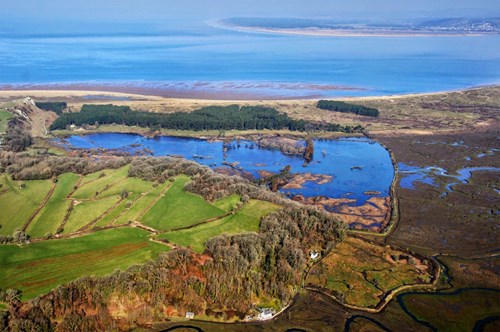Cwm Ivy Marsh Habitat Creation Project
Background 
The project, the first of its kind in Wales, will look at how best to recreate up to 39 hectares (almost 100 acres) of new saltmarsh habitat so the Cwm Ivy Marsh can be further reintegrated back into the wider estuary.
Sea level rise means the Cwm Ivy sea wall is already being overtopped by high tides and storms. This, combined with the poor condition of the wall, caused the naturally occurring breach.
As a result of prolonged heavy rainfall in November 2013, the sea wall enclosing Cwm Ivy Marsh was damaged and a small hole emerged. This allowed small amounts of sea water into the marsh. The constant passage of sea water at every high tide gradually opened the hole until a section of the wall and supporting embankment collapsed in August 2014. Since then, the sea has begun to gradually reclaim the marsh and the breach in the sea wall has continued to grow.
New intertidal habitat for wildlife and ecosystems
This proposed new intertidal habitat will not only provide important new feeding and resting sites for birds and other wildlife, but will also ensure that the special wildlife value and ecosystems of the Burry Inlet and Carmarthen Bay will be protected long into the future.
Compensatory habitat for future flood defences in Carmarthen Bay
This new saltmarsh will help provide ‘compensatory habitat’ that will be needed to offset the likely loss of saltmarsh habitat in the future due to a combination of sea level rise due to climate change and the need for new coastal flood defences in Carmarthen Bay in accordance with Shoreline Management Plan policies.
Public drop in sessions
We have been looking at a range of options of how best to create a salt marsh at Cwm Ivy. This involves consideration of economic, environmental, and technical aspects, and we have talked to a wide range of people to gain their views.
We held two public drop-in sessions on Friday 5th June and Saturday 6th June 2015 in Llanmadoc. The event was well attended and we received a large amount of feedback.
We have considered this feedback as part of our assessment when agreeing our preferred option on how best to create saltmarsh habitat at the site. Digital copies of the drop-in boards and project factsheet can be found on this page.
Our option shortlist
Our shortlisted options considered how best to create the new saltmarsh habitat whilst taking local opinion, economic, environmental and technical aspects into consideration.
These were;
Option 1: No active intervention; work with nature to allow the saltmarsh to develop naturally. The breach will continue to widen naturally as other sections of the embankment are likely to fail in the future
Option 2: Widen the breach to 20m
Option 3: Widen the breach to 100m to allow the tide to flow into and out of the marsh more easily
Option 4: Create additional breaches in the embankment to further improve how the tide flows into and out of the marsh
Option 5: Undertake small-scale works in the marsh to improve drainage in the marsh, assisting with the development of saltmarsh.
Preferred option and next steps
Having reviewed the evidence gathered by our independent consultants, Natural Resources Wales and National Trust have reached an agreement on the habitat creation project at Cwm Ivy marsh.
Our evidence suggests the best way to create a successful saltmarsh habitat at Cwm Ivy would be option 4 - “to create additional breaches in the embankment to further improve how the tide flows into and out of the marsh”.
However, we acknowledge this would present City and County of Swansea (CCS) with significant challenges in undertaking their statutory responsibilities in respect of a highway maintainable at public expense under the Highways Act 1980.
Natural Resources Wales and National Trust do not want to take forward an option which is incompatible with CCS’s duties as the Highway Authority.
CCS is currently seeking funds to commission a structural survey of the embankment and undertake an options assessment for access which is likely to impact on how we proceed with the saltmarsh creation project.
Until CCS have has completed their access assessment and have decided what actions they will take, our preferred option will defer to Option 1 – “No active intervention; work with nature to allow the saltmarsh to develop naturally. The breach will continue to widen naturally as other sections of the embankment are likely to fail in the future”.
This means the Cwm Ivy Marsh Project Board cannot progress either option 1 or option 4 as the preferred option, until CCS’s intention with regard to shoring up the existing breach is confirmed.
The project defaults to Option 1 until this information is received.
This decision was agreed during a project meeting between Natural Resources Wales, National Trust and City and County of Swansea on Wednesday 15 September 2015.
Roles and Responsibilities at Cwm Ivy
NRW’s role in this project is to create a new saltmarsh habitat and ensure the Wales Coast Path remains continuous around the Cwm Ivy coastline. It is the lead partner in this project.
National Trust is the landowner and manager for the majority of the Cwm Ivy marsh. It is a partner in this project.
City and County of Swansea’s (CCS) role in this project is to manage or maintain the Cwm Ivy sea wall Public Rights Of Way (PROW).
Contact
For more information about the project please call us on 0300 065 3000 (Mon-Fri, 9am-5pm) or email enquiries@naturalresourceswales.gov.uk
Alternatively you can write to us at the following postal address:
Natural Resources Wales
Tŷ Cambria,
29 Newport Road,
Cardiff,
CF24 0TP.
Thank you.
Image provided to NRW for use by kind permission by G R Howe, Gower Society. Copyright G R Howe
